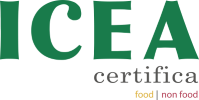EU Organic Farming (Regulation (EC) No. 834/07)
It certifies agricultural products, processed agri-food products, feed and pet food, aquaculture products, algae and microalgae (spirulina), yeasts.
It guarantees the conformity of organic production at all stages of the production chain, from farm to table, in compliance with the EU regulations (Regulation (EC) No. 834/07 and (EC) No. 889/08)
What it is certified
Food preparation
The organic standards also define precise rules for the preparation of plant and animal products, aimed at limiting the use of additives, flavourings and other non-organic ingredients with mainly sensory and technological functions.
Only the milder and more direct natural additives (citric acid, ascorbic acid, etc.) are allowed, for some of which the use of the organic version is encouraged (e.g. pectin, lecithin, locust bean gum etc.). Nitrites and nitrates are permitted only for cured meats and other meat products, with strict restrictions on the usage levels.
The same applies to sulphites whose use is permitted only for the production of wine, cider (always with restrictions in the final product) and for the preservation of crustaceans.
Any added flavourings may only be used if classified under Community legislation as “natural flavourings”.
The use of ionising radiation and any substance derived from or produced from GMOs is always prohibited even for the few common ingredients allowed.
Only multi-ingredient products that contain at least 95% organic certified agricultural ingredients (excluding water, salt, additives and natural flavourings) are defined as “organic”. The remaining 5% may only consist of few ingredients, not available on the Community market; such ingredients are reported in a particular list within the regulation (Regulation (EC) No. 889/08, Annex IX).
The same ingredient cannot be present in both the organic and conventional versions at the same time.
Organic production shall take place guaranteeing separate processing over time (thanks to dedicated plants) or in space. In the latter case, the installation shall be adequately cleaned before starting the organic production.
The records shall allow a correct identification and reporting of incoming and outgoing flows of raw materials and finished products.
How to certify
The certification process is divided into five main phases:
- Notification of organic production activity to the competent authority through the Biological Information System (SIB) or similar regional systems. The operator shall declare the type of activities, production units and activity chains subject to control. Firms involved in food preparation shall state the production plants where organic preparation in carried out including any subcontractors not directly subject to the control system.
- Initial assessment of the production process, the operator shall submit a management plan to describe all the measures he intends to take to comply with the organic requirements relating to the activity carried out. The operators involved in food preparation shall provide the Annual Preparation Plan (PAP), the list of organic raw materials suppliers, and the recipes of all those products for which the certification is required.
- Start-up inspection to verify the correct application and effectiveness of declared management plan measures and other related documents. In addition, the suitability of the structures and the correct management of the company’s production processes are assessed as required by the European regulations for the different fields of activity.
- Issue of Documentary Evidence and Certificate of Conformity based on the information and data collected as part of the assessment and verification process. The Certificate of Conformity lists the certified products. The certificate of conformity shall report the list of certified products and their classification according to the production method, ‘organic’ or ‘in conversion to organic farming’. The labels on the products shall be prior authorised by the ICEA competent office.
- Annual surveillance through periodic inspections and planned analyses based on a careful risk analysis, aimed at confirming the maintenance of compliance conditions and the prompt and accurate keeping of the mandatory records required for control purposes.
Documents and downlodable files
[button color=”green” size=”normal” alignment=”none” rel=”follow” openin=”newwindow” url=”https://www.icea.bio/wp-content/uploads/2017/01/2.-M0202-Regolamento-Tecnico-834-Ed03-Rev00-Certificazione-Biologica-EU-Europa-ICEA-Istituto-di-Certificazione-Etica-e-Ambientale.pdf”]Regulation for certification[/button]
[button color=”green” size=”normal” alignment=”none” rel=”follow” openin=”newwindow” url=”https://www.icea.bio/wp-content/uploads/2017/01/3.-M0201-Contratto-certificazione-834-Ed02-Rev04-Certificazione-Biologica-EU-Europa-ICEA-Istituto-di-Certificazione-Etica-e-Ambientale.pdf”]Contract for certification[/button]
[button color=”green” size=”normal” alignment=”none” rel=”follow” openin=”newwindow” url=”https://www.icea.bio/wp-content/uploads/2017/01/4.-L.0501-Linee-guida-etichettatura-Ed.03Rev00-Certificazione-Biologica-EU-Europa-Preparazione-alimentare-ICEA-Istituto-di-Certificazione-Etica-e-Ambientale.pdf”]Labelling guidelines[/button]
[button color=”green” size=”normal” alignment=”none” rel=”follow” openin=”newwindow” url=”https://www.icea.bio/wp-content/uploads/2017/01/5.-M0206_Piano-di-gestione-preparatori-Ed03-Rev02-Certificazione-Biologica-EU-Europa-Preparazione-alimentare-ICEA-Istituto-di-Certificazione-Etica-e-Ambientale.docx”]Management Plan[/button]
[button color=”green” size=”normal” alignment=”none” rel=”follow” openin=”newwindow” url=”https://www.icea.bio/wp-content/uploads/2017/01/6.-M0330-Scheda-preparazione-vino-Ed02-Certificazione-Biologica-EU-Europa-Preparazione-alimentare-ICEA-Istituto-di-Certificazione-Etica-e-Ambientale.xls”]Wine preparation sheet[/button]
[button color=”green” size=”normal” alignment=”none” rel=”follow” openin=”newwindow” url=”https://www.icea.bio/wp-content/uploads/2017/01/7.-L0209-Misure-antifrode-ICEA-Ed03-Rev00-Certificazione-Biologica-EU-Europa-Preparazione-alimentare-ICEA-Istituto-di-Certificazione-Etica-e-Ambientale.pdf”]Anti-fraud measures[/button]
[button color=”green” size=”normal” alignment=”none” rel=”follow” openin=”newwindow” url=”https://www.icea.bio/wp-content/uploads/2017/01/8.-M0205-allegato-B-Misure-precauzionali-Ed03-Rev02-Certificazione-Biologica-EU-Europa-Preparazione-alimentare-ICEA-Istituto-di-Certificazione-Etica-e-Ambientale.pdf”]Annex B – Precautionary measures[/button]
[button color=”green” size=”normal” alignment=”none” rel=”follow” openin=”newwindow” url=”https://www.icea.bio/wp-content/uploads/2017/01/11.-M0301-Elenco-fornitori_Ricetta-Preparazione-Ed02-Rev02-Certificazione-Biologica-EU-Europa-Preparazione-alimentare-ICEA-Istituto-di-Certificazione-Etica-e-Ambientale.xlsx”]Suppliers’ list Preparation Recipe[/button]
[button color=”green” size=”normal” alignment=”none” rel=”follow” openin=”newwindow” url=”https://www.icea.bio/wp-content/uploads/2017/01/13.-M0326-Accordo-Conto-Lavorazione-Ed02-Certificazione-Biologica-EU-Europa-Preparazione-alimentare-ICEA-Istituto-di-Certificazione-Etica-e-Ambientale.pdf”]Tolling Agreement[/button]
[button color=”green” size=”normal” alignment=”none” rel=”follow” openin=”newwindow” url=”https://www.icea.bio/wp-content/uploads/2017/01/7-Modulo-negozi-3B.6-Certificazione-Biologica-EU-ICEA-Istituto-di-Certificazione-Etica-e-Ambientale.zip”]Points of Sale [/button]
Contact ICEA
ICEA Piemonte, Liguria e Valle D’Aosta

